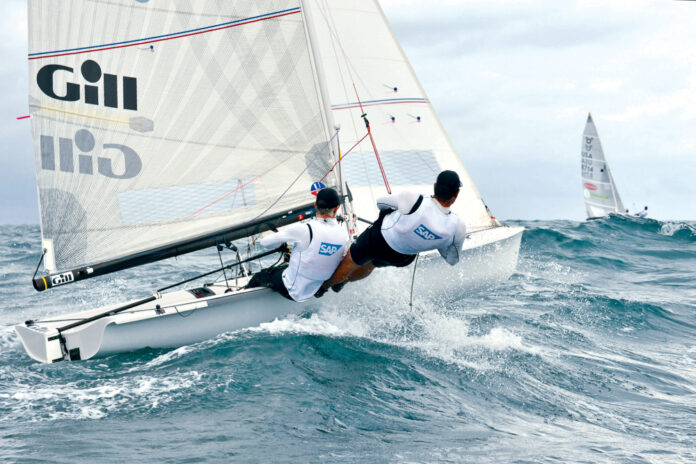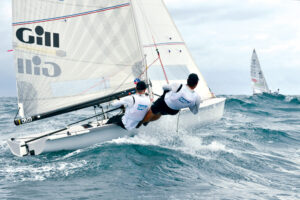

Sailing techniques for waves and chop. Few sailing challenges are as demanding as racing through waves and choppy water. Maintaining speed and momentum in these conditions can make the difference between victory and defeat.
Below I explore the best techniques for sailing in rough water and how to keep your boat moving fast when every second counts.
Understanding the Waves
Before going into specific techniques, it’s important to understand the nature of waves and how they interact with your boat. Waves in open water are typically caused by wind, and their size and frequency depend on factors such as wind speed, duration, and fetch (the distance over which the wind blows).
In choppy conditions, there are two main types of waves:
- Wind waves: These are the result of wind action on the water surface.
- Swells: These are longer-period waves that have travelled from their area of generation.
Understanding the differences and how to read these is the first step in mastering rough water sailing.
BOOK FOR YOUR SAILING BUDDY (and one for yourself)
Upwind Sailing Techniques
Going upwind in choppy conditions presents unique challenges. Below are some key techniques to maintain speed and control:
-
Find the Groove
In waves, finding and maintaining the right angle to the wind is crucial. This “groove” is typically a few degrees lower than you might sail in flat water. The goal is to keep the boat moving through the waves rather than slamming into them.
-
Power Up in the Lulls, Depower in the Gusts
As you encounter waves, you’ll also experience variations in wind strength. Be prepared to adjust your sail trim constantly:
- In lulls, ease the mainsheet slightly to power up the sail.
-
Steer Through the Waves
Instead of trying to maintain a constant course, work with the waves:
- Head up slightly as you approach a wave to reduce impact.
- Bear off on the back of the wave to accelerate.
This technique, known as “wave steering,” helps maintain boat speed and reduces the jarring and speed-sapping effect of hitting waves head-on.
-
Adjust Your Weight Distribution
Proper weight distribution is critical in choppy conditions:
- Move weight forward when going upwind to prevent the bow from rising too much on waves.
- In larger waves, be prepared to move weight aft quickly to prevent burying the bow.
-
Use the “Bow Down” Technique
When faced with particularly large waves, use the “bow down” technique:
- As you approach the wave, bear off slightly and ease the mainsheet.
- This allows the boat to slice through the wave rather than climb it.
- Once through, head up and trim in to regain your course.
Downwind Sailing Techniques
Sailing downwind in waves requires careful technique to maintain control and speed.
-
Surf the Waves
The key to fast downwind sailing in waves is to catch and ride the waves:
- As a wave approaches from behind, head up slightly to match its speed.
- Once on the wave, bear off to accelerate down its face.
- Be ready to head up again as you reach the bottom to catch the next wave.
-
Use the Apparent Wind
Remember that your apparent wind will shift forward significantly as you accelerate down waves. Be prepared to adjust your sail trim accordingly:
- As you accelerate, steer down and ease sails as necessary to maintain optimal shape.
- Trim in as you slow down and steer up between waves.
-
Master the Asymmetric Spinnaker
If you sail with an asymmetric spinnaker, learn to use it effectively:
- Experiment with different angles to find the fastest and most stable course.
- Be prepared to adjust the spinnaker trim constantly as you surf waves. The luff should be curling continuously which ensures that the sail is exhausting effectively.
-
Practice Gybing
Gybing in waves requires precise timing and execution:
- Try to gybe on the face of a wave when the boat is most stable and moving fast.
- Be prepared for sudden changes in apparent wind direction during the gybe.
BOOK FOR YOUR SAILING BUDDY (and one for yourself)
General Tips for Maintaining Speed in Choppy Water
Regardless of your point of sail, these general tips will help you maintain speed in rough conditions:
-
Keep the Boat Flat
A flatboat is a fast boat. Use crew weight and sail trim to keep the boat as level as possible, even in waves.
-
Minimize Rudder Movement
Excessive rudder movement creates drag. Use subtle steering and try to steer with weight movement and sail trim as much as possible.
-
Stay Focused and Anticipate
Choppy conditions require constant attention. Always be looking ahead, anticipating the next set of waves and adjusting your course and trim accordingly.
-
Practice Excellent Sail Trim
In rough water, good sail trim becomes even more critical:
- Adjust your outhaul, cunningham, and vang to power up or depower as needed.
- Be prepared to make constant small adjustments as conditions change.
-
Maintain Momentum
Once you’ve built up speed, do everything you can to maintain it. It’s much harder to accelerate from a slow speed in choppy conditions.
Mental Preparation and Strategy
Sailing in waves isn’t just about physical technique; it’s also a mental game:
-
Stay Calm and Focused
Rough conditions are stressful, especially during a race. Practice staying calm and focused, even when things get challenging.
-
Develop a “Feel” for the Boat
The best sailors develop an intuitive feel for their boat in different conditions. This comes with practice, time in the boat and experience.
-
Learn to Read the Water
Develop your ability to read the water ahead of you. Look for patterns in the waves and areas where the water might be slightly calmer.
-
Stay Flexible in Your Strategy
Be prepared to adjust your race strategy based on the conditions. A rigid plan that doesn’t account for choppy water can quickly fall apart.
BOOK FOR YOUR SAILING BUDDY (and one for yourself)
Conclusion
Mastering the art of sailing in waves and choppy water is challenging but rewarding. It requires a combination of technical skill, physical stamina, and mental acuity.
Every boat and every set of conditions is unique. Use these techniques as a starting point, but don’t be afraid to experiment and develop your own style.
With time and practice, you’ll find yourself not just surviving in choppy water, but thriving.

